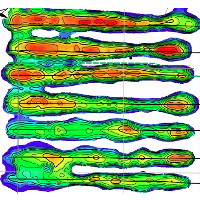4D Seismic in SAGD confirms bitumen thickness
 In his application, this operator included a discussion of 4D seismic technique and interpretation. He believes that 4D seismic images a steam chamber and helps confirm the bitumen thickness.
In his application, this operator included a discussion of 4D seismic technique and interpretation. He believes that 4D seismic images a steam chamber and helps confirm the bitumen thickness.
He says a 4D seismic anomaly is created with the oil sand is heated to 60 degrees C. He notes a rise in anomaly over time as well as lateral growth. He believes his work shows that steam chambers coalesce between the toes of the injectors.
Check out his discussion about the use of 4D seismic in his application documents. Help yourself through our self-serve, secure check out.
Buy these submission docs now Subscribers get them for freeThe application also proposes and experiment to drill infill wells using side track technology rather than starting fresh from the surface. He hopes to save cost and improve recovery using this side-track technology in this pattern.
?subject=I want just a few email alerts&body=Sign me up for a few email area alerts. %0D%0A%0D%0AMy Name:___%0D%0AMy Phone Number:___%0D%0A%0D%0AType of applications___%0D%0ACentered on this UWI___%0D%0ARadius proximity from there___%0D%0A%0D%0APricing: www.appintel.info/just-alerts/%0D%0A%0D%0A(Or call AppIntel Sales at 403-803-2500.)">Contact us now to buy just a few cheap and cheery email alerts.
The nice thing about seeing this application, is that you can determine exactly which pad will contain his side-track experiment. Then you can watch his SOR and production as a result of the new side-track infill well. Hopefully you can quickly learn from his mistakes and copy his successes.
Each AER application contains your neighbor's perspective on the exploitation of oil and gas formations. Applications contain more technical ideas even than SPE or CSEG papers.
Would you like to see what other operators in your areas are thinking about seismic, commercial schemes, experimental schemes and recovery? AppIntel can help.
Tags: Seismic, Thermal, Heavy Oil
1 Jun 2016

Non-meridian thermal wells
Still drilling horizontal wells N-S? Why?

Steam surfactant co-injection
Want to win? What is your competitive advantage?

Surprise! Sour gas production from a sweet thermal scheme
Dealing with surprises in the oil and gas industry. What to do next.

10 ways to increase production before Christmas - Infographic
For your wall to remind you

10 ways to increase production before Christmas
Each cost less than half a million

Using AI to reduce risk of oil and gas failure
How can you assess the risk without knowing the epic fails?




 Calgary, Alberta, Canada
Calgary, Alberta, Canada
 Share
Share